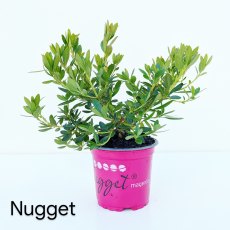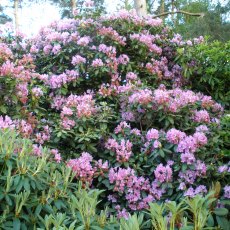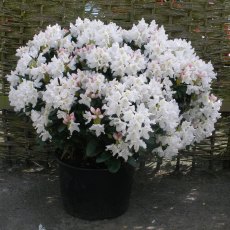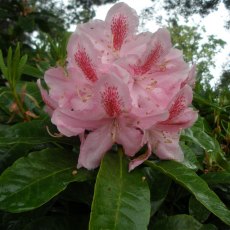Rhododendron Brigitte INKARHO
Item: IBRIG
 In stock
In stock
May-June
Light Pink
100-125cm
Not Scented
No
Below -20 °C
Collect in Store
This item is available for collection.
Home Delivery
UK mainland delivery from £8.95
Now available on the Inkarho rootstock! Very pretty pale pink flowers with a darker pink edge in late May and early June. This plant has fine shiny foliage and has a compact habit, growing wider than tall. Height 100-120cm in 10 years.
Plant with plenty of good ericaceous compost to aid establishment.
- Recommended for: Pretty flowers and good foliage.
- Easy to grow.
- Ideal position: Most garden situations, dappled shade.
- Habit: Dense.
- Group: Hybrid.
- Parentage: insigne (s) X 'Mrs J. G. Millais'.
- Hybridization date: pre 2000 (1965)
- Bred by Hans Hachmann. Origin: German.
- Ideal soil: pH 4.5 to 7.5.
- RHS Hardiness Rating: H7.
- How we propagate this plant: Graft.
Customer Reviews



Good to know
These are the plants which we have featured in our recent RHS Chelsea Flower Show exhibits, with extensive reporting on the BBC Chelsea TV programme. Interest from new customers around the country has been exceptional, and gardeners have been delighted to learn that they can now grow their favourite plants on most garden soils.
The revolutionary new ‘Inkarho’ lime tolerant rootstock is particularly recommended for growing rhododendrons on neutral clay soils, up to pH7. This patented rootstock was developed from a rhododendron growing in a German lime quarry, and has been the subject of an extensive 20 year breeding and testing programme. They are grown under licence in Germany, and are some of the few plants that we have to buy in. Choice tall hybrids and compact yakushimanum varieties are grafted on the rootstock enabling them to be grown in a much wider range of soil types than ever before. They are hungry plants and require more feeding than other Rhododendrons to keep their foliage a healthy dark green. We recommend our own recipe Millais Nurseries Slow Release Fertilizer and plenty of good Ericaceous compost for best performance. Failures are rare, but occur when there is insufficient soil preparation, and insufficient feed. Without feed, the plants will start to wither and the foliage will go yellow.
The varieties selected are all tough and will flower from a young age. For a guide to plant spacing, use the height we give in 10 years as a guide to the distance between each plant. Plant no deeper than the top of the rootball, and dig in plenty of good ericaceous compost around the sides. Feed at the rate of a teaspoon of ericaceous slow release fertilizer per plant at the 4 litre size, rising to a tablespoon per plant for a 12 litre plant, and a small handful for a more mature specimen. For growing in pots, please select the lower growing yakushimanum hybrids, and use good Ericaceous compost
Please note: Some varieties are wider than their height, especially yakushimanum hybrids. Specimen size plants (eg 80-90cm) will be measured by their largest measurement which could be the spread of the plant.
For further advice, For further advice, see here
Size Guide

The Basics
Ideal soil
Acidic soil, good organic content, pH 4.5-6.0. Inkarho range of rhododendrons will tolerate soils up to pH7.5
Sun or Shade
Light dappled shade is best for most varieties.
Shelter
Refer to hardiness rating. Give young plants protection.
Site Selection
Avoid close to trees, roots, invasive weeds, walls, hot patios, dry banks and waterlogged soils. Do not use weed matting or stone mulch.
Plant spacing
Use the height shown in 10 years as a guide to the distance between each plant. Allow room for plant to fill out. If planting closer for instant impact, be prepared to move plants after a few years.
Compost
- 3 litre pot, dig in 10-20 litres of ericaceous compost.
- 7.5 litre pot, dig in 20-30 litres of ericaceous compost.
- 70-80cm specimen, dig in 60 litres of ericaceous compost.
- 100-120cm specimen, dig in 120 litres of ericaceous compost.
Planting depth
Plant high in the ground, with the top of the rootball visible.
Feeding
Slow-release ericaceous feed recommended in March and straight after flowering.
Mulch
Recommended every few years.
Water
The key ingredient! Keep moist all season, especially the critical time at end of June for flower bud initiation. Tap water is better than no water. Heavy dose at least once per week in dry weather.
Drainage
Ensure good drainage in winter, especially with yellow flowering varieties. Avoid waterlogged sites.
Pruning
Rhododendrons and Camellias: Not normally required. Tidy wayward shoots after flowering.
Evergreen azaleas and Bloombux can be clipped into a low hedge.
Magnolias and Acers: Formative pruning when young to shape into a tree or bush.
Deadheading
Remove old flower-heads, particularly on young or weak plants.
For further advice see here
Delivery & Returns
Our website calculates the delivery charge according to weight and delivery location throughout the UK. To see these charges, please enter your postcode at the checkout, and you will see the charge vary as you add more items to your wheelbarrow.
 Millais Nurseries
Millais Nurseries














